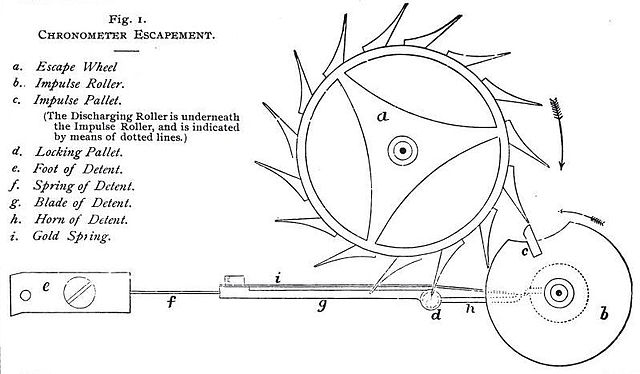The lever escapement, invented by the English clockmaker Thomas Mudge in 1754, is a type of escapement that is used in almost all mechanical watches, as well as small mechanical non-pendulum clocks, alarm clocks, and kitchen timers.
A lever escapement in a mechanical watch. The largest brass circle is the balance wheel. The escape wheel is the silver gear above and to the right of it whose bearing is surrounded by decorative engraving. Most of the lever itself is hidden, but both pallets are visible.
An escapement is a mechanical linkage in mechanical watches and clocks that gives impulses to the timekeeping element and periodically releases the gear train to move forward, advancing the clock's hands. The impulse action transfers energy to the clock's timekeeping element to replace the energy lost to friction during its cycle and keep the timekeeper oscillating. The escapement is driven by force from a coiled spring or a suspended weight, transmitted through the timepiece's gear train. Each swing of the pendulum or balance wheel releases a tooth of the escapement's escape wheel, allowing the clock's gear train to advance or "escape" by a fixed amount. This regular periodic advancement moves the clock's hands forward at a steady rate. At the same time, the tooth gives the timekeeping element a push, before another tooth catches on the escapement's pallet, returning the escapement to its "locked" state. The sudden stopping of the escapement's tooth is what generates the characteristic "ticking" sound heard in operating mechanical clocks and watches.

Original drawing from around 1637 of the pendulum clock designed by Galileo, incorporating the escapement.
Pin wheel escapement of South Mymms tower clock
First detent escapement by Pierre Le Roy 1748.
Earnshaw's detent escapement, used widely in chronometers.





